Tuesday, December 5, 2023
Resume
What are the most recognized designer city?
Cities themselves aren't typically designed by a single person, but certain architects and planners have left a lasting impact on urban landscapes. Some renowned figures associated with city design include Pierre L'Enfant for Washington, D.C., Baron Haussmann for Paris, and Daniel Burnham for Chicago. However, the design and development of cities are often collaborative efforts involving many professionals over time.
What are the most recognized designers and research institutions urban planning?
Some well-recognized urban planning designers include Jan Gehl, Jane Jacobs, and Rem Koolhaas. Notable research institutions in urban planning include MIT's Department of Urban Studies and Planning, Harvard Graduate School of Design, and the Urban Land Institute.
Other influential urban planning designers include William H. Whyte, Christopher Alexander, and Kevin Lynch. Research institutions like the Urban Institute, Center for Urban Science and Progress (CUSP) at NYU, and the Lincoln Institute of Land Policy are also noteworthy for their contributions to urban planning research and development.
Additional renowned urban planners include Richard Florida, Elizabeth Plater-Zyberk, and Andres Duany. Institutions like the Institute for Transportation and Development Policy (ITDP), the Brookings Institution, and the American Planning Association (APA) play significant roles in urban planning research and practice.
Notable urban planning figures include Ebenezer Howard, known for garden city concepts, and Kevin Lynch, renowned for his work on urban form. Leading research institutions include the Lincoln Institute of Land Policy, the European Council of Spatial Planners (ECTP), and the Consortium for Sustainable Urbanization (CSU).
In the field of urban planning, Walter Gropius, founder of the Bauhaus School, and Ebenezer Howard, a pioneer of the garden city movement, are noteworthy. Research institutions like the Urban Design Group, the International Society for City and Regional Planners (ISOCARP), and the Center for Urban Environmental Research and Education (CUERE) contribute significantly to the discipline.
Neom
including Sir Peter Cook, Jean Nouvel, Kent Larson & Eui-Sung Yi, Indy Johar, Hanif Kara & Willy Muller, Massimiliano Fuksas & Doriana Mandrelli Fuksas, Mark Lutter, Edward Glaeser & Benjamin Bratton.
NEOM SHARES ITS VISION FOR THE FUTURE OF CITIES IN VENICE EXHIBITION
From May 20 to September 24, 2023, NEOM, Saudi Arabia’s futuristic gigacity, will showcase the exhibition titled ‘Zero Gravity Urbanism – Principles for a New Livability’ in Venice. Curated by Ramon Prat, this exhibition presents groundbreaking proposals from renowned architects like Morphosis, Sir Peter Cook, UNStudio, Fuksas, Oyler Wu, DMAA, and Adjaye Associates, highlighting their contributions to THE LINE and the urban revolution it represents.
This exhibition aims to tackle global environmental and social challenges while emphasizing the importance of striking a harmonious balance between nature conservation, livability, and sustainable human progress. In addition to the display, the event features a series of engaging talks and presentations from distinguished architects, academics, and urban thinkers from across the globe, including Sir Peter Cook, Jean Nouvel, Kent Larson & Eui-Sung Yi, Indy Johar, Hanif Kara & Willy Muller, Massimiliano Fuksas & Doriana Mandrelli Fuksas, Mark Lutter, Edward Glaeser & Benjamin Bratton.
A RADICAL APPROACH TO URBAN PLANNING
NEOM’s exhibition will be held at the historic Abbazia di San Gregorio in Venice, showcasing a radical approach to urban planning that emphasizes the delicate balance between nature, livability, and human progress. Unlike traditional city development of the past century, NEOM (find more here) presents a sustainable model that addresses the world’s most urgent environmental and urban challenges, while accommodating the needs of a rapidly growing urban population. This model also tackles issues such as urban sprawl and climate change.
From a conservation standpoint, THE LINE proposes a city that can house up to 9 million residents while utilizing only 2% of the land footprint of cities with a similar population. This ensures that nature can flourish, safeguarding 95% of NEOM’s vast land area. Moreover, THE LINE sets an example as a city fully powered by renewable energy sources, with sustainable water and food production systems in place. From a human perspective, THE LINE’s innovative three-dimensional layout of private and public spaces ensures universal and equitable access to amenities and services. Additionally, every resident will enjoy direct views and immediate proximity to nature. The city is designed to be car-free, instead prioritizing hyper mixed-use walkable communities that provide convenient 5-minute access to daily necessities.
Working on THE LINE with some of the most recognized designers and research institutions has resulted in a significant body of work that re-establishes our urban realm as a space for human and cultural exchange.’ Tarek Qaddumi, Executive Director of Urban Planning of NEOM, adds.
NEom
Antoni Vives, Chief Urban Planning Officer of NEOM, said; “Brought to life in Venice through the design proposals and intellectual contribution of the world’s leading architects and urban thinkers, Zero Gravity Urbanism represents a proposal of how humanity can better respond to the urban challenges we face globally.”
Tarek Qaddumi, Executive Director of Urban Planning of NEOM, said, “Tonight represented an important next step onto the global stage for Zero Gravity Urbanism, as the world’s wider architecture community now has the opportunity to see the depth of thinking and work that has gone into this incredible project from so many prominent thinkers and architects.”
According to Dezeen, while the exhibition predominantly focuses on The Line, which is Neom’s largest and most well-known component, there is also a gallery dedicated to the other three officially announced regions. This gallery showcases large models and visualizations of Oxagon, Trojena, and Sindalah. In total, Neom will consist of ten regions; however, no details regarding the other six have been disclosed.
At the Venice Architecture Biennale 2023, the Danish studio BIG was announced as the masterplanner for the floating port city of Oxagon, a significant component of the Neom development in Saudi Arabia. For details on the public program and to register for complimentary tickets visit neomvenice.com.
New Commercial Hub in Shanghai
Save this picture!Ennead Architects Reveals Masterplan for New Commercial Hub in Shanghai - Image 1 of 7 Written by Maria-Cristina Florian Published on May 16, 2022 Share Ennead Architects has unveiled the Shanghai Lingang Special Area master plan, a new hub for global commerce. Designed around the central axis that defines the Dishui Lake district in Shanghai, the master plan establishes the identity of a new business district. Designed as a free trade zone, this is planned to attract prominent international companies. The site's design proposes functional areas where multinational corporations can optimize business operations while creating open spaces for the surrounding communities. Ennead’s large-scale plan includes four commercial buildings, retail, civic and open spaces.
One of the key features of the Shanghai Lingang Special Area will be “The Ring,” a large-scale centerpiece anchoring the design of the whole district. This circular, cantilevered observation deck, and museum will afford 360-degree views of nearby Dishui Lake, Shanghai, and the Pacific Ocean while also providing space for cultural experiences. Four mixed-use towers support this imposing structure that combines long, curved spans and structural glazing. The Ring's design is the result of a collaboration with structural engineer JAE and façade consultant RFR.
The two towers flanking the Ring will accommodate office spaces for international corporations. The Tower Waterfall and Tower Rhomboid are designed to become two of the most easily recognizable features of the new business district. Similar in scale, the towers have distinct identities, with the Tower Waterfall being defined by curved, intersecting shapes, while the Tower Rhomboid features angular sawtooth patterning.
The new district aims to accommodate a variety of civic functions, degrees of density, and natural and built environments for people to work in and inhabit. The sub-districts include the Quad of Free Trade, Eco and Art Centers, the Mixed-Use Commercial Zone, and the Mixed-Use Residential Neighborhood. A series of linear elevated parks, landscaped with local flora, will connect commercial and retail spaces. The Financial Crescent, an avenue defined by interconnected buildings that incorporate natural elements, will reinforce the central axis and unify the entire district. The plan is designed to offer over 89,000 square meters of retail space, over 7,500 square meters of civic space, and approximately 28,000 square meters of open space.
Ennead designed the site to act as “a sponge city.” The abundant green spaces play a crucial role in absorbing excess rainwater, helping to mitigate any potential damage from storms and flooding while moderating temperatures and reducing erosion. Landscaped pedestrian spaces and rooftop gardens bring office workers and residents closer to nature. Natural motifs have also inspired the site's design, looking to the shapes of the Dishui Lake and the ripples forming on its surface to create a built environment well integrated into its natural surroundings.
The ambition was to create a 21st-century free trade hub that elevates the profile of Shanghai as a global economic player. Ennead’s masterplan and designs for individual plots support this vision by establishing a compelling and inspired identity that speaks to the importance of this region. - Grace Chen, Principal and Director of Asia Practice at Ennead Architects
Ennead Architects established an office in Shanghai in 2014 and has been active in Asia for a long time. The firm has completed more than 40 projects in China, spanning from ground-up new construction of hi-tech and commercial office complexes to adaptive re-use of existing historical and industrial buildings and significant cultural projects. Ennead has designed many innovation campuses, including Huawei Research and Development Campus, Xiaomi International Headquarters in Shenzhen, and Zhangjiang Science City in Shanghai. The firm is also responsible for the Shanghai Astronomy Museum, which opened in 2021, and the anticipated Shenzhen International Performance Center.
Build a city
Imagine having a blank canvas on which to master-plan a brand new city; drawing its roads, homes, commerces, and public spaces on a fresh slate and crafting its unique urban identity. Every urban planner has fantasized about designing a city from scratch and luckily for some, this dream is morphing into concrete opportunities. Over the last two decades, new, master-planned cities have emerged from the ground up at an unprecedented scale, the majority of which have been created in Asia, the Middle East, Africa, and Latin America, with currently over 150 new cities in the making. This new type of urban development has shown to be particularly seductive in emerging markets, where they are sold as key parts of the strategy to leapfrog from agriculture and resource-based systems to knowledge economies by attracting foreign capital and boosting economic growth. According to Forbes, “The new city building movement that we are currently in the middle of is one of the most under the radar and most misinterpreted social and economic developments happening in the world today”. Dr. Sarah Moser, Professor at McGill University, Director of the New Cities Lab and leading expert on the topic, describes new city projects as an “attempt to create a new, relatively self-sufficient urban area that is geographically separate from existing cities, has its own name, and is governed separately from existing cities''. In contrast to suburbs or offshoots of existing cities, they are purpose-built organisms that hold their own identities, presenting a clean slate with a number of opportunities that make them attractive to the private sector. Save this picture! A distinct characteristic that unites this wave of new cities is their tendency to market themselves with their own brand, identity, and vision - not so differently than a start-up would pitch itself to investors. With its country clubs, gated communities and premium shopping malls, Saudi Arabia’s King Abdullah Economic City (KAEC) markets itself as the region’s key manufacturing and logistics hub and as the city of choice for the young elite who seek to invest in the new economy. Its website boasts “connected communities with access to the pristine waters of the Red Sea”, a residential district with “an 18-hole golf course”, and a “luxurious Esmeralda health and leisure club“. Along with 4 other economic cities, the $100bn privately-run megaproject forms part of the Saudi Vision 2030, an economic diversification strategy to shift away from the country’s dependence on petroleum. NEOM, the most audacious of the 4 projects, is a $500bn Silicon Valley-inspired megalopolis (33 times the size of New York City) designed as a center for renewable energy, biotechnology, manufacturing, media, and entertainment. Self-described as “an accelerator of human progress”, it aims to be a living laboratory for technologies such as autonomous mobility solutions (including flying drone-powered taxis) and port logistics handled by artificial intelligence - all the while being fully powered by locally generated renewables. Save this picture! To facilitate the creation and development of these ambitious new ventures, NEOM and KAEC operate within Special Economic Zones (SEZs), where they enjoy business and trade laws that differ from the rest of the country. This is a strategy that has been replicated in many new cities around the world, as the combination of favorable legislation and tax incentives (in addition to the creation of real estate land inherent to the development of new cities) make them more conducive to foreign direct investment. So, how did we get here in the first place? While there has been a marked increase in new city development over the last 20 years, building cities from scratch is not a new phenomenon. We’ve been building cities from the ground-up since the great cities of antiquity, and more recently, during the 1960s wave of modernist, purpose-built government seats like Brasilia and Chandigarh. But what is it about the last two decades that has led to the latest wave of new city building? Moser explains this as a symptom of unique global conditions, including the emergence of real estate as an asset class, neoliberalism, and the deregulation of economies, as well as the growing role of tech companies in ‘smart’ urban development. This has made the creation of new cities alluring to multinational tech corporations such as Cisco, Google, Microsoft and IBM, all of which have shown a keen interest in their development. South Korea’s $40-bn master-planned ‘smart city’ of Songdo, one of the pioneers of the new city movement, provides an illustrative example. Built on a 600-hectare stretch of reclaimed land, the city serves as a testing ground for Cisco technologies, which has wired all corners of the city with synapses and aims to gather real-time data to optimize city living for Songdo’s citizens. Save this picture! The official rationale for new city-building is compelling as the projects are typically sold as opportunities for developing economies to spark growth, gain a place on the world stage and even reinvent their national identities. From Norman Foster-designed Masdar City in the UAE to Eko Atlantic, Nigeria’s “new Dubai”, computer-generated visualizations depict utopian visions of smart, ‘eco-cities’ that hold promises of a more modern and prosperous future. However, the darker side of the entrepreneurial approach to city-making is that there appears to be a stark gap between stakeholders’ official rationale and the reality of these developments - more often than not, they’re conceived as investment magnets for the private sector and economic elite. Government officials and developers reap large gains by buying tracts of land which they can sell for steep prices (upon announcing the creation of the new city), opening the door for construction companies to receive their own slice of profit during the building phase. In other words, there’s a lot of money to be made before anyone even moves in, and with many units being sold as investment properties, meeting occupancy goals is far from given. Putrajaya, Malaysia’s “Intelligent Garden City”, has managed to receive just over 90,000 of the
NEOM Unveils Siranna, its Latest Tourist Destination in Saudi Arabia
NEOM has just introduced “Siranna,” a new tourismdestination within the new sustainable regional development evolving in Northwest Saudi Arabia. Aiming to blend innovation and refinement, while integrating with the coastal terrain, the design seeks to offer a luxury escape, with a 65-key hotel and 35 residences. Prioritizing minimal intervention in nature, Siranna’sdevelopment utilizes specific techniques to preserve the local landscape. The architecture pays tribute to the area’s heritage while blending into the mountains and wadi. The initiative aligns with NEOM’s dedication to creating sustainable spaces in nature.
Accessible to guests via water transportation, the design according to the official statement "emphasizes relaxation, inviting visitors to immerse themselves in the many facilities: spas, wellness spaces, a signature beach club, and scenic trails for exploration by foot or horseback." Moreover, Siranna is part of NEOM'scommitment to creating spaces that foster creativity and well-being, giving visitors and residents a place to unwind and gain new perspectives.
Monday, December 4, 2023
More connectivity
More vibrant
Unique region logistique
Airport with system intégré
Cairo 45 billion
Indonesian 35 billions
Harmonious blend of modernité et traditions
Breath taking nature
World class port
https://youtu.be/TTY6PA5iqPI?si=jj_CEkrLq1vB10kT
The line
$20 billions
https://youtu.be/hBnVJjbP-ms?si=7G8OyaWMEspIqnoI
Architecture specialied in 3dt rendering
Sunday, December 3, 2023
saudi
17 of Saudi Arabia’s biggest construction megaprojects
Saudi Arabia is undergoing transformation at breakneck speed, as the Kingdom aims to reduce its dependence on oil and diversify its economy to incorporate public services and tourism under its Vision 2030 project.
While headline-grabbing projects like the 170km linear city, The Line garner huge amounts of publicity, elsewhere in the country, there is a wide array of other ambitious projects worth many billions of dollars, presenting opportunities for architecture, engineering and construction companies all over the world.
International Construction takes a look at 17 of Saudi Arabia’s biggest megaprojects:
Four of those projects - The Line, Oxagon, Sindalah and Trojena - are in the special economic area of Neom in the northwest of Saudi Arabia.
Together they are expected to cost in the region of $500 billion.
The AlUla Project
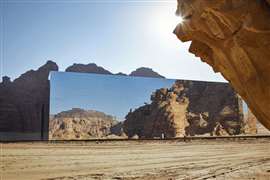 Maraya, meaning ‘mirror’ in Arabic, is a piece of art set in the desert canyon of Ashar Valley (Image: Royal Commission for AlUla)
Maraya, meaning ‘mirror’ in Arabic, is a piece of art set in the desert canyon of Ashar Valley (Image: Royal Commission for AlUla)The AlUla project involves developing an archaeological, cultural and tourist complex in a region the size of Belgium, with the aim of making the AlUla, an ancient oasis city in the Medina province, into one of the Kingdom’s cultural capitals. Hegra, an archaeological site in the AlUla area, is Saudi Arabia’s first UNESCO World Heritage Site.
Ongoing construction projects include the Sharaan Resort close to Hegra, designed by French architect Jean Nouvel, which is inspired by the ancient techniques of the Nabataean inhabitants of the region who crafted monuments into sandstone in the area more than 2,000 years ago. Two new museums in the region – the Contemporary Art Museum and the Museum of the Incense Road have also broken ground in AlUla.
Diriyah Gate
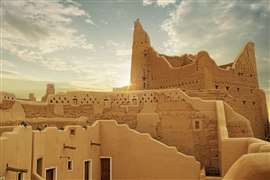 Diriyah (Image: Diriyah Gate Development Authority)
Diriyah (Image: Diriyah Gate Development Authority)The Public Investment Fund (PIF)-backed Diriyah Company is in charge of restoring historic Diriyah, the first capital of Saudi Arabia. Under the Kingdom’s Vision 2030 plan, seven square kilometres of Diriyah, 15 minutes north-west of Riyadh city centre, will be transformed as part of a US$63 billion scheme.
Work has already started on the Diriyah Gate ‘gigaproject’ which involves creating entertainment, retail, hospitality, education, office and residential areas, including more than 20 hotels and a collection of museums. One of the first areas to undergo a transformation will be the Bujairi district, to “beautify” the area, improve infrastructure, and build a new arts centre – Diriyah Art Oasis, as well as a new 142-key hotel called the Samhan Heritage Hotel. Work is also underway to restore two square kilometres of the historic Wadi Hanifah, forming part of the Diriyah Gate masterplan, including restoring historic palm groves and farms, combined with new walking trails and picnic areas.
Jeddah Central
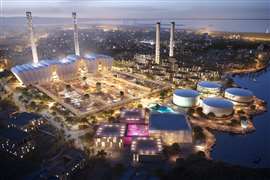 Heatherwick Studio has revealed plans for its proposed conversion of a former desalination plant into a museum and arts centre as part of the Jeddah Central project (Image: Heatherwick Studio)
Heatherwick Studio has revealed plans for its proposed conversion of a former desalination plant into a museum and arts centre as part of the Jeddah Central project (Image: Heatherwick Studio)Jeddah Central is another massive urban development project, covering 5.7 million sq m in the centre of the city of Jeddah. The project aims to make Jeddah into a world-class destination capitalising on its location on the Red Sea coast and its proximity to religious pilgrimage destinations Makkah (also known as Mecca) and Madinah. The project will come in three phases, the first of which is due for completion at the end of 2027. It involves the construction of a 9.5km waterfront with a marina ready to receive yachts from inside and outside the kingdom, 2.1km of sandy beach, an opera house, a museum, a sports stadium, an Oceanarium and coral farms.
Eventually it will see the construction of 17,000 housing units and 2,700 hotel rooms. Last year, Jeddah Central Development Company, which is a subsidiary of the PIF, also signed a memorandum of understanding with two companies – Waterise and Ajlan & Bros Holding Group – to pursue and develop the implementation of new deep sea desalination technology to supply the city with clean water.
Jeddah Economic City (and Jeddah Tower)
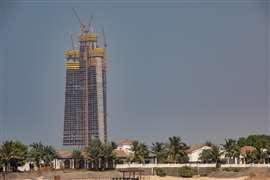 Construction on the 1km-tall Jeddah Tower has stalled but there are plans for a 2km-tall tower in Saudi Arabia (Image: Adobe Stock)
Construction on the 1km-tall Jeddah Tower has stalled but there are plans for a 2km-tall tower in Saudi Arabia (Image: Adobe Stock)The future of Jeddah Economic City, a $20 billion development occupying 5.3 million sq m of land along the coastline of the Red Sea, had been unclear. Promising a “new era in urban development and living”, it involves the construction of residential quarters, business areas, commercial centres and diplomatic quarters, as well as academic institutions.
At its centre will sit what will become the world’s tallest tower, the 1km-high Jeddah Tower.
Construction on the tower, overseen by local contractor Saudi Binladen Group and designed by Chicago firm Adrian Smith + Gordon Gill Architecture, started in 2015. Originally, its cost was estimated at $1.2 billion and saw the construction of a huge 5m-thick concrete slab, sitting on top of 270 piles to support the massive tower.
By 2017, the tower reached 63 storeys but work came to a halt after two major backers of the project – Prince Alwaleed and Bakr bin Laden – were arrested during a purge ordered by new Crown Prince of Saudi Arabia, Mohammad bin Salman bin Abdulaziz Al Saud.
But the project is reported now reportedly “back in full motion”. A total of 14 contractors from across the world have been invited to bid to complete the tower, with a deadline for tenders of the end Q of this year.
King Salman Park
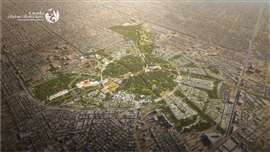 King Salman Park (Image: By Ghifar, CC BY-SA 4.0)
King Salman Park (Image: By Ghifar, CC BY-SA 4.0)King Salman Park is a 16 sq km public space, five times the size of New York’s Central Park, named after Saudi Arabia’s ruler since 2015, King Salman bin Abdulaziz. Located in north-central Riyadh and designed by Saudi engineering firm Omrania and Danish firm Henning Larsen, it will contain a 90,000 sq m Visitor Pavilion, whose construction has been awarded to an unnamed Saudi company.
The Pavilion, designed by British architect David Adjaye, will include a plant nursery, multi-use hall, meeting rooms, exhibition areas, restaurants and cafes. The park, backed by the King Salman Park Foundation, will involve planting a million trees. As of last year, the King Salman Park Foundation had awarded contracts worth SAR 3.85 billion (US$1 billion) for its construction, including site preparation works, several tunnels and bridges, and infrastructure and preparation works in the Royal Arts Complex. The Foundation also signed an agreement with the Saudi Electricity Company to establish five power stations to supply the park with a total capacity of 580MW. It is set to open in 2024.
The Line (Neom)
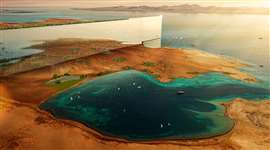 A rendering of The Line (Image courtesy of NEOM)
A rendering of The Line (Image courtesy of NEOM)One of the most ambitious construction projects anywhere on the planet, The Line is a multi-billion-dollar linear city that, if completed, would be 170km in length and only 200 metres wide. Neom claims that the city will run on 100% renewable energy and will eventually be home to nine million people. Instead of roads, it will be linked by a single high-speed rail line, with a journey from end to end taking just 20 minutes. Construction work began in late 2021 and geotechnical specialist contractor Keller, which won a major piling contract for the project in 2022, is among companies working on the scheme. The first district of the city, called ‘Hidden Marina’ is set to open to residents by 2030.
Giles Pendleton, executive director of the project, has previously indicated that modern methods of construction will help the project team to deliver the vast project more quickly than conventional builds. Among the technologies Pendleton listed as being employed on the project were: modular construction, digital twins, 3D printing, augmented reality for design coordination and on-site decision making, drones for surveying, and even artificial intelligence and robots.
Masar
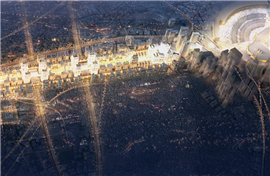 Digital render of how Masar Makkah will look from above (Image: Duncan & Ross)
Digital render of how Masar Makkah will look from above (Image: Duncan & Ross)Masar is the name of a project to redevelop a 1.2 million sq m strip of land in the centre of Makkah, close to the Grand Mosque. It will involve the construction of tens of thousands of hotel and residential units, as well as retail and commercial space. Private developer Umm Al Qura, which owns Masar Destination, recently bought land in Makkah costing SAR 900 million (US$240 million) for the construction of new residential towers. So far, a total of nearly SAR 40 billion (US$11 billion) has been spent on Masar Destination, according to Umm Al Qura.
Mohammed bin Salman Non-profit City (MISK)
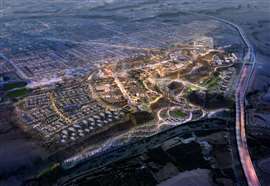 Digital render of Mohammed bin Salman Non-profit City (Image: Mohammed Bin Salman Misk Foundation)
Digital render of Mohammed bin Salman Non-profit City (Image: Mohammed Bin Salman Misk Foundation)A 20-minute drive from downtown Riyadh, Mohammad bin Salman Non-Profit City is supported by Crown Prince and Prime Minister of Saudi Arabia Mohammed bin Salman’s personal foundation. The city promises to be an “incubator for youth and volunteer groups as well as local and international non-profit institutions”. It will cover 3.4 sq km and be home to schools, colleges, a conference centre, a science museum, an arts academy and gallery, a theatre and a residential complex.
UK-based Mace Consult is signed up to support the Foundation in delivering the MISK Foundation Centre, a centrepiece to the city. The Foundation Centre will cover 6,000 sq m of office accommodation and features a large internal atrium-covered garden and is due to open within the next couple of years.
The Mukaab (and New Murabba)
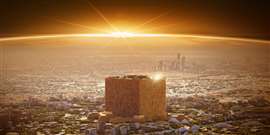 A visual of the Mukaab in the New Murabba downtown area (Image courtesy of Saudia Arabia PIF)
A visual of the Mukaab in the New Murabba downtown area (Image courtesy of Saudia Arabia PIF)Saudi Arabia’s Public Investment Fund unveiled plans for one of its latest mega-projects – a 400m tall and 400m wide cube city called The Mukaab – early this year. The building, which the PIF claims would be large enough to hold 20 Empire State Buildings, will be the centrepiece of a new downtown in Riyadh.
It is part of the wider New Murabba project announced by Mohammad bin Salman. The New Murabba Development Company will oversee the project.
The Mukaab promises to be one of the largest built structures in the world. Inspired by the modern Nadji architectural style, its developers claim that it will be able to offer “ever-changing environments” using digital and virtual technology to create holographics.
The wider New Murabba project will feature green areas and walking and cycle paths to promote healthy lifestyles. It will also be home to a museum, technology and design museum, theatre, and more than 80 entertainment and cultural venues. It will sit at the intersection of King Salman and King Khalid roads to the northwest of Riyadh, over an area of 19 sq km. The plan involves building 104,000 residential units, 9,000 hotel rooms, 980,000 sq m of retail space, and 1.4 million sq m of office space. The entire project is due for completion in 2030.
Oxagon (Neom)
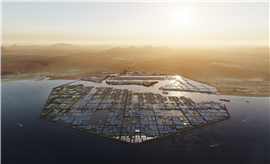 What Oxagon in Saudi Arabia may look like
What Oxagon in Saudi Arabia may look likeOxagon will be home to a research and innovation campus and what its developers claim will be a sustainable port with a fully automated and integrated supply chain. In May this year, a consortium of contractors won a contract worth SAR 3 billion (US$800 million) to build the first phase of the Port of Neom.
Belgian contractor Besix and Boskalis have become the first European contractors to win a design and build lump sum contract with NEOM, to build the first phase of the region’s port. Work will involve dredging and construction of quay walls. Besix will work with local partner Modern Building Leaders (MBL) to design and build more than 3km of quay walls.
Oxagon will also contain a residential community and in July it emerged that hospitality giant IHG has won a deal to build a new 250-bed hotel there. The Hotel Indigo property will open in 2026.
Qiddiya
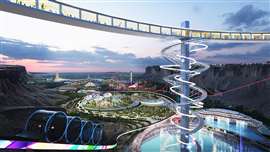 Aerial view of Qiddiya’s Festival Grounds and resort core (Image: Qiddiya)
Aerial view of Qiddiya’s Festival Grounds and resort core (Image: Qiddiya)Qiddiya is another ‘gigaproject’ backed by the Public Investment Fund. It involves building a ‘disruptive’ new destination city based around entertainment, sports and culture. It will feature theme parks, sports arenas, a Jack Niklaus-branded golf course, academies for sports and the arts, concert and entertainment venues, race tracks and nature and environment experiences, as well as housing. Qiddiya will be around 45km from the centre of Riyadh, covering an area of 376 sq km, with 223 sq km of planned development area.
Red Sea Global
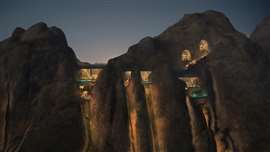 Desert Rock, a mountain resort being built into the rockface as part of the Red Sea, is more than 50% complete (Image: Red Sea Global)
Desert Rock, a mountain resort being built into the rockface as part of the Red Sea, is more than 50% complete (Image: Red Sea Global)Another project backed by the PIF, Red Sea Global claims to be the most ambitious luxury tourism development in the world.
Currently, it comprises two destinations announced by Crown Prince Mohammad bin Salman, called the Red Sea, on the west coast of the country, and Amaala on the northwestern coast.
So far, the Red Sea’s first three hotels and phase one of Red Sea International Airport are on track to open later this year, with a further 13 hotels and supporting infrastructure to follow.
Work is underway on 11 resorts and infrastructure across Shura Island, with 100 construction contracts in place and a similar number out to tender.
Developer Red Sea Global has also installed more than 760,000 photovoltaic panels to power phase one of the Red Sea. One of its five solar farms is located near Six Senses Southern Dunes, The Red Sea, which will be the first hotel to open at The Red Sea in the coming months.
On Sheybarah Island, RSG has installed 38 prefabricated stainless steel overwater villas.
Upon full completion, The Red Sea will comprise 50 resorts offering up to 8,000 hotel rooms and more than 1,000 residential properties across 22 islands and six inland sites.
Amaala’s first phase of development is focused on its Triple Bay masterplan, which will offer 1,300 rooms in eight hotels. The first hotels there will open in 2024, ahead of completion in 2027. When complete, Amaala will have over 3,000 hotel rooms across 25 hotels, 943 luxury residential villas, as well as high-end retail and food outlets, a yacht club, wellness, and recreational facilities.
Roshn
Backed by Saudi Arabia’s Public Investment Fund, Roshn Group is a real estate developer in charge of delivering 400,000 homes across Saudi Arabia by 2030. Its goal is to increase the Kingdom’s rate of home ownership to 70%.
In September, the company announced four major commercial partnerships, totalling over SAR 9 billion (US$2.4 billion). It has signed a deal with Chinese contractor China Harbour Engineering Company (part of China Communications Construction Company), to develop 6,700 residential units, mosques, community centres, retail and public amenities at Roshn’s Sedra and Warefa communities in Riyadh. Roshn claimed that the SAR 7.7 billion (US$2.1 billion), 45-month contract is the largest in value to be announced among Saudi gigaprojects to date.
Saudi Downtown
The Saudi Downtown Company, once again owned by the PIF, is a collection of 12 projects across 11 regions of Saudi Arabia and covering 10 million sq m of land. Each project is a mixed-use development that aims to improve lifestyles and promote economic growth through the construction of shopping, hospitality, tourism, office and housing schemes. The 12 cities involved are: Al-Madinah Al-Munawarah, Al-Ahsa, Al-Khobar, Buraydah, Taif, Arar, Hail, Tabuk, Dumat Al-Jandal, Jizan, Najran, and Al-Baha.
Saudi Entertainment Ventures (Seven)
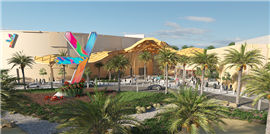 Digital render of the Seven development (Image: Saudi Arabia’s Public Investment Fund)
Digital render of the Seven development (Image: Saudi Arabia’s Public Investment Fund)PIF-owned entertainment and recreation company Saudi Entertainment Ventures (Seven) has started construction work on a new destination in Almadinah in the west of the Kingdom, with an investment of SAR 1.3 billion (USD$350 million). The project involves a 4,000 sq m family entertainment centre with an e-karting track, a Discovery Adventures centre offering treks, treehouse trails and educational missions, and a Play-Doh entertainment centre.
Construction has started with BUJC, a joint venture between Al Bawani Co and UrbaCon Trading and Contracting carrying out construction works. The project is part of Saudi Arabia’s plans to welcome 100 million visitors per year by 2030.
Sindalah (Neom)
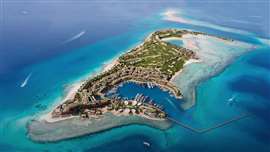 Digital render of Sindalah (Image: Neom)
Digital render of Sindalah (Image: Neom)Sindalah has been billed as an 84-hectare luxury island resort in the Red Sea with three luxury hotels, a golf course, restaurants and over 50 retail outlets. It will also serve as a “yachting gateway” to the Mediterranean. Scheduled for completion in 2024, it will be the first element of the wider Neom development to reach completion.
Trojena (Neom)
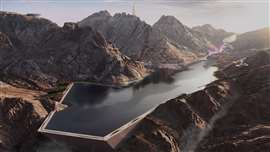 Digital render of Trojena (Image: Neom)
Digital render of Trojena (Image: Neom)Neom has announced plans for Trojena, a ski resort 50km from the Gulf of Aqaba coast. While it seems an unlikely development for a desert kingdom, Trojena will be at altitude, with mountains in the region ranging from 1,500m to 2,600m high and experiences sub-zero winter temperatures. Neom said the alpine and adventure sports resort would cover nearly 60 square kilometres, featuring 36km of ski slopes, 42,000 sq m of retail and dining outlet space, over 3,600 hotel rooms and serviced apartments, and a 3,000-seat mountainside amphitheatre.
Other Neom projects: Alongside the four different regions of NEOM, other major construction projects are taking place to provide the infrastructure around them. In May this year, a joint venture between Italian contractor Webuild and its Saudi Arabian counterpart Sajco won a US$1.5 billion (€1.4 billion) contract to build a high-speed rail line connecting The Line with Oxagon, for example.
Meanwhile, French engineering and project management company Assystem has won a deal to conduct a series of pre-development studies for up to 20GW of solar energy plants within Neom.
The solar parks could cover up to 420 sq km of space across seven planned solar photovoltaic parks in the Tabuk and Duba regions in the northwest of the country.






















